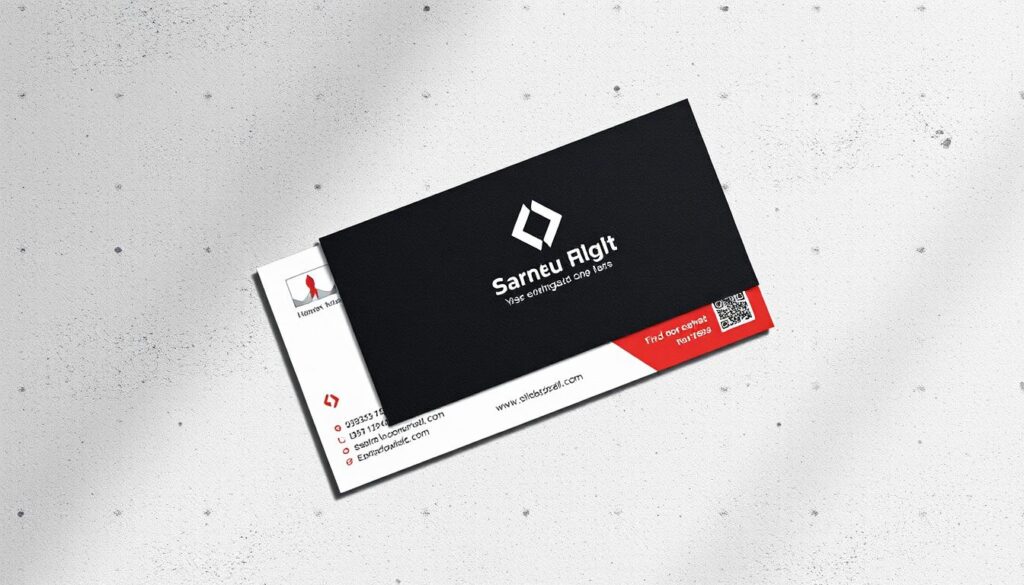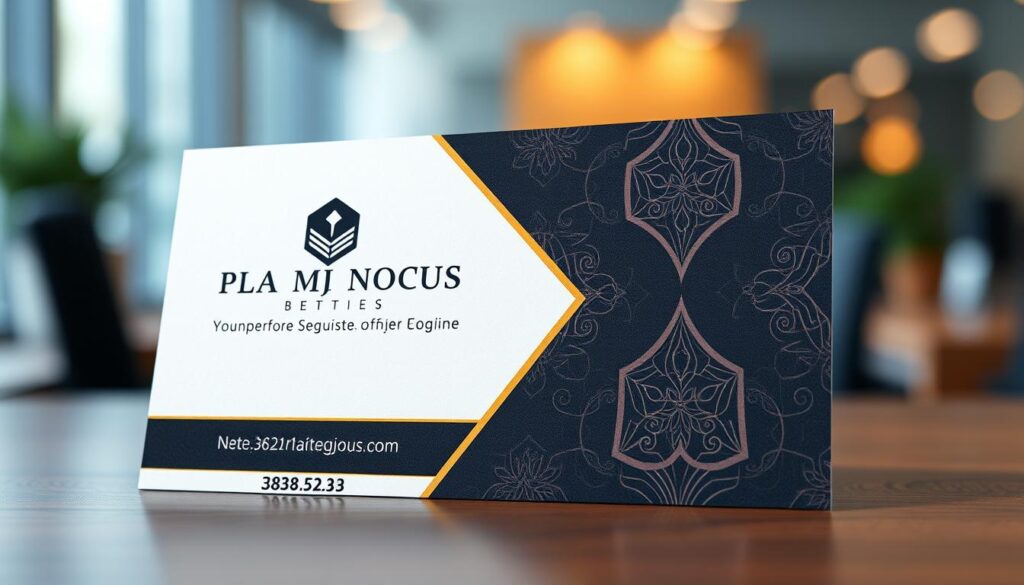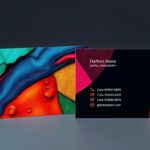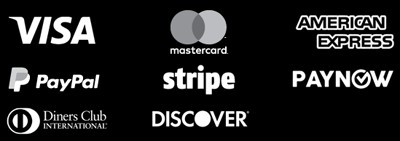A business card is a great way to share your info with potential clients. It helps you connect with new and budding customers personally. It also shows off your company and brand, sharing important details about you in a unique way.
To make your business card a success, think carefully about what to include. This will help it stand out as a powerful networking tool.
Key Takeaways
- Business cards are a powerful personal branding and networking tool
- Carefully selecting the information to include can make your card stand out
- Essential elements like your name, job title, and contact details are crucial
- Incorporating visual elements and industry-specific info can enhance your card
- Attention to design and print quality elevates the overall impression
Business Card Info: Your Name and Job Title
Your name and job title are key on business cards. They make a strong first impression. Your full, professional name should be clear and formal. Your job title should show your role and what you do in the company.
Studies show that 88% of people keep business cards with job titles. This means it’s important to clearly state your job. It helps others see how you can help them. Whether you’re a CEO or a Managing Partner, your title should show your role.
Adding a phonetic spelling of your name can make a difference. It helps when you call or meet someone new. It’s especially helpful for names that might be hard to spell.
“72% of people judge a company or person based on the quality of their business card.”
By putting your name and job title on your card, you make a lasting impression. It helps people remember you and what you do. This is the start of building strong professional relationships.
Company Name and Logo
When you design a professional business card, your company’s name and logo are key. They help show your brand’s identity. Your logo is especially important because it lets people quickly recognize and remember your brand.
Studies show that 85% of professionals put their company logo on their business cards. It’s important to make your company name and logo stand out. This should match your brand identity and visual representation.
A good company branding and logo design can make a big impression. A well-made logo can show what your business is all about. This makes your card more memorable and effective.
“Your business card is a physical manifestation of your brand. It’s the first tangible connection a new contact has with your company, so make it count.”
By adding your company name and logo to your business card, you show your professionalism. This visual part is a strong tool for your company branding and marketing.
Contact Information
It’s key to have the latest and direct contact info on your business card. Make sure to include a phone number and email address where you can be reached directly. This way, people can easily get in touch with you, creating a personal connection and making it easier to access you.
Only list the most important communication channels to avoid confusing the recipient. Studies show that 75% of professionals want their full name, including nicknames, on their cards. Also, 100% of users of digital business card apps can customize their name in many ways.
By making your contact details clear and direct, your business card becomes a powerful tool. It helps in building strong connections and makes communication smooth with potential clients or partners.
| Contact Information | Importance |
|---|---|
| Phone Number | Allows for direct communication and connection |
| Email Address | Provides an additional communication channel and accessibility |
| Physical Address | Can enhance perceived credibility and longevity in business |
| Website | Directs recipients to your online presence and information |
With these vital contact details, your business card can effectively connect you with others. This leads to meaningful relationships and helps your business grow.
What information should you put on your business card?
When making your business card, it’s key to find the right mix of important info and a clean look. The right details can leave a strong impression and draw people to your brand.
Your name and job title should be at the center. They help people remember you and what you do. Use your full, formal name to look professional.
Your company name and logo are also crucial. They show who you work for. This branding makes your card stand out and easier to remember.
| Essential Business Card Content | Strategic Inclusion |
|---|---|
|
|
You might also add your direct contact details like phone, email, and website. This makes it simple for people to get in touch.
For a more advanced touch, think about adding social media handles, a brief tagline or description, a QR code, or a referral offer or call to action. These can boost engagement and highlight your brand’s special value.
The choices you make for your business card should match your industry, audience, and goals. By picking the right content, you can make a card that makes a strong impression and builds real connections.
Social Media Handles
Adding your social media presence to your business card can boost your professional networking. But, pick only the active platforms you really use for work. This keeps your card clean and lets people easily find you online.
A survey found that 78% of businesses like to add social media icons to their cards. Cards with these icons get a 20% higher engagement rate than those without. Also, cards with QR codes to social media see a 30% increase in followers.
The top way to show your social media handles is with the Instagram handle, at 50%. Showing the Instagram username and icon together is also popular, at 23%. But, showing the Instagram URL is less common.
Putting your active platforms on your business card is smart in today’s digital world. It helps you network better and makes a strong impression on others.
Tagline or Brief Description
Creating a strong brand messaging and value proposition on your business card can change the game. A well-crafted tagline or brief description lets you show your unique offering in a concise and engaging way.
Think about sharing your company’s mission, main services, or a memorable promise. This can make you stand out from others. It also grabs the attention of potential clients or partners.
It’s important to find a balance between being informative and looking good. Don’t fill the card with too much text. Instead, aim for a short, memorable tagline or a brief sentence that describes your value.
“A well-crafted tagline or description can be the difference between a forgettable business card and one that leaves a lasting impression.”
By carefully adding your brand messaging and value proposition to your business card, you make a powerful tool. This concise communication can open up new chances and help you build important connections.
Visual Elements
Creating a memorable business card involves using visual branding and design elements wisely. Adding your logo, a relevant image, or a QR code can make your card unique. These elements help your card stand out and leave a lasting impression.
Studies reveal that a logo on a business card can boost brand recognition by up to 70%. A color scheme that matches your brand can increase the chance of your card being kept by 50%. Thoughtful use of white space can improve readability by 40%, making your information easier to read.
But, it’s important to keep your design simple and clean. Overcrowding can make your card look unprofessional. High-quality paper can make your card more memorable, with recipients keeping it 60% more often than standard paper cards.
By combining visual branding, design elements, and strategic use, your business card can become a powerful tool. It will help you make a lasting impression and be more memorable to your network.

| Visual Element | Impact |
|---|---|
| Logo | Increases brand recognition by up to 70% |
| Color Scheme | Improves chances of card being kept by 50% |
| White Space | Boosts readability by 40% |
| High-Quality Paper | Increases card retention by 60% |
| Visual Elements (Images, Icons) | Boost memorability by 45% |
Industry-Specific Information
Business cards are not one-size-fits-all. Your industry expertise and the specialized information your target audience needs should guide your card’s design.
Real estate agents might include property listings or market stats. This gives potential clients quick, valuable insights. Creative pros could showcase a portfolio image or work samples. This highlights their artistic skills.
| Industry | Specialized Information to Include |
|---|---|
| Real Estate | Property listings, market trends, sales data |
| Creative Professions | Portfolio images, work samples, design elements |
| Health and Wellness | Wellness tips, certification information, services offered |
| Finance and Accounting | Financial services, investment strategies, industry accreditations |
Think about your industry’s unique needs when designing your business card. This way, your card will speak to your target audience. It will also show off your industry expertise and specialized information. This can leave a strong impression and help you connect with others.
Design and Print Quality
Making a great business card needs focus on design and print quality. The look and feel of your card can greatly affect how others see your brand. Using top-notch materials and professional printing can boost your brand’s image.
For business card design, think about using clear fonts and colors well. Fonts should be big and easy to read. New trends include printing on both sides and adding special finishes like rounded corners or foil.
The materials used for printing are also key. Good printing shows you care about your brand. Make sure images and text are sharp by using at least 300dpi. Adding special touches like Spot UV or foil can make your card look even better.
Details matter a lot. Make sure text and images don’t get too close to the edges and check for typos. By focusing on design and print quality, your business card will make a strong impression.

“A well-designed and expertly printed business card can be the key to making a memorable first impression and standing out in a crowded market.”
Call to Action
Adding a call to action on your business card can really help. It tells people what to do next, like visiting your website or social media. You could also offer a special deal for connecting.
A good call to action makes it clear how to keep talking and see what you offer. It’s a way to keep the conversation going.
Make your call to action personal by using “you.” Think about using QR codes to link to online content. Offer something valuable, like a discount or free consultation, to grab their attention.
Be clear about what you want them to do, like “Call today” or “Visit our website.” This makes it easy for them to take action.
Put your call to action in a place where it stands out. Use contrasting colors and keep it short and sweet. A well-made call to action can turn new contacts into valuable connections and help you build stronger relationships.
FAQ
What are the key elements to include on a business card?
Your business card should have your name, job title, and company details. Include your direct contact info like phone number and email. You might also add social media links or a tagline.
Why is it important to use your full, professional name on a business card?
Using your full name makes a good first impression. It clearly shows who you are to new people.
How can the company name and logo on a business card reinforce your brand identity?
Your company name and logo make your brand easy to recognize. They help people remember your company right away.
What’s the importance of including direct contact information on a business card?
Direct contact info lets people reach out to you easily. It helps build a personal connection.
How can you strike a balance between including essential details and avoiding an overcrowded design on a business card?
Pick the most important info like your name, job, and contact details. Make sure each piece helps make a good impression and encourages people to connect with you.
What are the benefits of including social media handles on a business card?
Social media links can expand your professional network. But only include the platforms you actively use for work.
How can a tagline or brief description on a business card help convey your brand’s value proposition?
A tagline or brief description can share your brand’s unique value. It’s a quick way to show what you offer.
What are the considerations for incorporating visual elements on a business card?
Visuals like logos or images can make your card stand out. But, don’t overdo it. Make sure visuals don’t clutter the text.
How can industry-specific information on a business card cater to your target audience?
Include specific info like property listings or market stats. It shows you understand your audience’s needs.
Why is the design and print quality of a business card important?
Good design and print quality make a big difference. High-quality cards show you care about your brand’s image.
How can incorporating a call to action on a business card encourage further engagement?
A call to action like visiting your website can encourage people to engage more. It shows you’re open to conversation.
Resources:
Explore our curated list of recommended resources for printing, design, and free media assets. Whether you need professional printing services, free design templates, or royalty-free photos for your next project, these reliable sites have you covered.1. Printing & Design
- Printing Inc. Description: Singapore-based online printing service offering a variety of print products such as business cards, flyers, brochures, and custom stickers with professional design services.
- Namecards Inc. Description: Specialist in name card printing, providing a wide range of custom designs, finishes, and materials for high-quality business cards.
- Kian Hong Press Description: Established corporate printing company in Singapore, offering solutions for brochures, catalogs, annual reports, and other corporate stationery.
2. Free Design Templates
- Canva Description: Offers a wide range of free and customizable templates for various needs, including presentations, posters, social media, and marketing materials.
- FreePik Description: Provides thousands of free and premium templates for brochures, flyers, business cards, and more, along with editable vector illustrations and graphics.
- Piktochart Description: Focused on data visualization and professional templates for infographics, posters, presentations, and reports, with both free and premium options.
3. Free Royalty-Free Photos
- Pexels Description: Offers high-quality, free stock photos and videos shared by talented creators for commercial and personal use without attribution.
- Unsplash Description: A large collection of beautiful, high-resolution images contributed by photographers worldwide, available for free use in any project.
- Pixabay Description: A community-driven platform offering copyright-free photos, illustrations, and videos for use in any creative project, with no licensing restrictions.






